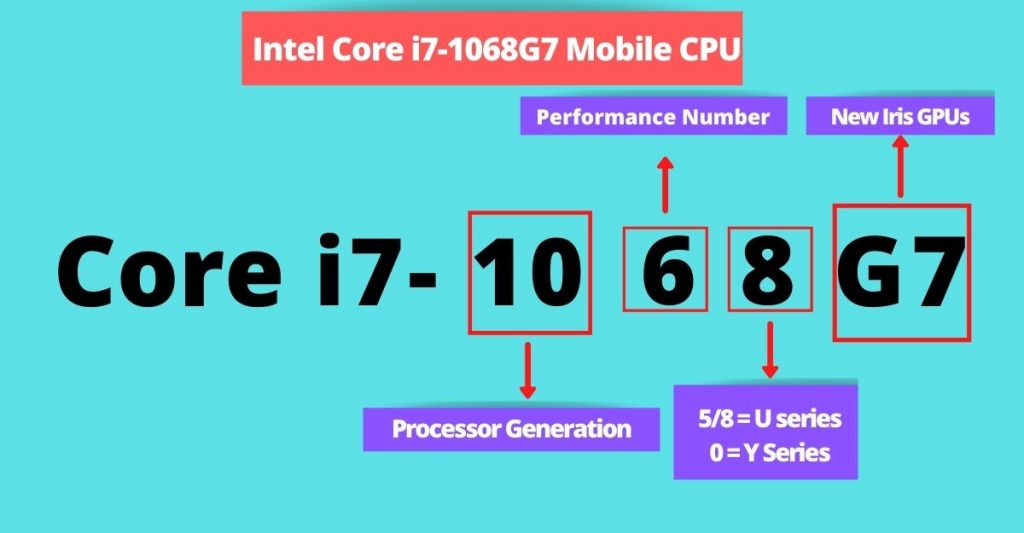In this article, let’s dive into ‘What does Numbers and Letters mean in Intel Processors’ this Intel naming scheme to clear the fog and help it decide which processors are built for which audience. While there are significant downsides to Intel CPUs such as weak onboard GPUs etc., one of the strangest but biggest downsides is how Intel chooses to name its processors and raises the bar for confusion every year.
Intel is one of the most well-known names in the market. The semiconductor giant has certainly played a huge role in changing the world and our lives thanks to its desktop and mobile (laptop) processors. But thanks to AMD stepping up with its Ryzen CPU series, Intel’s monopoly has waned in recent years.
Types of Intel Processor


Intel’s line of processors is divided into six segments: Core i3, Core i5, Core i7, Core i9, Celeron, and Pentium. We will talk about the first four as they are more common.
What is Core i3?
Core i3 is your most basic option. They are generally aimed at people who don’t multitask or play games. As a result, its cost is very low. If you want to browse the Internet or use Microsoft Office with ease, the latest Core i3 processor should suffice.
What Is Core i5?
The Core i5 is an excellent choice for multitasking and moderate amounts of gaming. The Core i5 stock-keeping units are a bit more expensive than i3s, but you can get a lot of an extra horsepower for that extra amount.
What Is Core i7?
Core i7 processors are primarily intended for game enthusiasts and content creators. When paired with the right GPU, the Core i7 should be able to handle anything you throw at it. This includes AAA game titles, heavy video editing, and 3D object rendering.
What Is Core i9?
Core i9 processors are slightly faster than Core i7. One of the key differentiating factors between them is better hyperthreading, which improves parallel computing. Things like a higher core count, more cache, and higher core clock speeds make the Core i9 better than the Core i7 processor.
It’s worth noting that desktop and mobile processors are very different when it comes to performance. A top-tier desktop Core i7 / i9 will outperform a top-tier mobile Core i7 / i9.
Desktop i7 / i9 demands better and more efficient cooling solutions readily available (eg liquid cooling). In contrast, mobile i7 / i9 processors, due to lack of space in laptops for better cooling systems, do not deliver as much power as they have to shrink the screen to generate less heat.
What does Numbers and Letters mean in Intel Processors
From 6th Generation To 9th Generation
Before the 10-generation processor mess, Intel’s naming scheme was pretty easy to understand. To better understand how Intel names its processors, let me give you an example.


Intel’s Coffee Lake line was without a doubt one of the company’s most popular. The 8th Generation Core i5 8250U was created for the laptop titled “Thin and Light Laptop”.
Here, “8” is, as you may have guessed, another 3-digit number, “250”, after the processor generation, which tells us how the processor will work. Other SKUs like the 8265U and 8350U will perform much better.
The line ends with a letter that, in this case, Intel’s U-series processors support lower clock speeds, which improves overall battery performance and reduces performance by a significant margin. These are used only on laptops.
Many other suffixes are used on both desktop and laptop processors. Here is a list of letters at the end of Intel processors.
Intel Processor Suffix Meaning
| Suffix | Meaning |
|---|---|
| G1-G7 | Graphics level (processors with new integrated graphics technology only) |
| E | Embedded |
| F | Requires discrete graphics |
| G | Includes discrete graphics on package |
| H | High performance optimized for mobile |
| HK | High performance optimized for mobile, unlocked |
| HQ | High performance optimized for mobile, quad core |
| K | Unlocked |
| S | Special edition |
| T | Power-optimized lifestyle |
| U | Mobile power efficient |
| Y | Mobile extremely low power |
| X/XE | Unlocked, High End |
Starting with the H, H, and HQ processor lines, these are commonly found in gaming machines. Like HK, which stands for high-performance overclockable, desktop processors have many processors with mixed keywords like “KF”, which stands for “overclockable without discrete graphics.”
For starters, think of overclocking as increasing the standard speed of a fuel engine. Higher speeds create more heat, which can affect the longevity of the motor, which in this case refers to the processor.
From 10th Generation
Intel changed its naming scheme to add a bit more confusion and went nuts naming the 10th gen processors. This Intel naming scheme is too difficult; Enthusiasts get it confused too.
Giant introduced the new letter “G” followed by a number “1-7” on the “Ice Lake” processors that come with the new Intel Iris graphics. In contrast, recent “Comet Lake” processors use older naming schemes that end with an alphabet.


Here G means graphics performance and you will get it only on mobile CPU. This means that a processor with a “G7” will have better graphics performance than a “G1”. Intel’s naming scheme for desktop processors remains the same as in previous generations.
Now you might be thinking, “Well it’s so easy isn’t it? So why the fuss?” And that’s where it gets most ridiculous. On Ice Lake Mobile CPUs, having a higher SKU number does not necessarily mean better performance.


Let us take four Ice Lake processors.
- i5-1035G7
- i5-1030G7
- i7-1065G7
- i7-1060G7
If I ask you to stack them based on their performance, starting from the most to least powerful, your answer might be this.
- i7-1065G7
- i7-1060G7
- i5-1035G7
- i5-1030G7
And here you are wrong. As you can see in the image above, the digit after the first three digits is not the number on the screen; Rather, it represents the series U / Y if it is 5/8 or 0, respectively. So this is the correct system.
- i7-1065G7
- i5-1035G7
- i7-1060G7
- i5-1030G7
This messy Intel naming scheme creates a lot of confusion when buying a laptop, and one wrong decision can ruin the time you spend with your shiny new machine.
Conclusion
From an enthusiast’s point of view, Intel needs to clear up the confusion caused by its naming schemes. But the bottom line is, he knows that not everyone decides to buy just by looking at the numbers. So we don’t see Intel adapting to simpler names anytime soon.
That being said, I can’t fail to mention the AMD Ryzen CPUs because they have improved a lot over time. The latest mobile Ryzen 4000 series processors are truly an engineering marvel. It strikes a perfect balance between energy efficiency and incredibly good performance. The Swift 3 powered by Acer’s Ryzen 4500U is one of the few machines that I have tested and was very impressed with it.
And that’s it for the ‘What does Numbers and Letters mean in Intel Processors’. Let us know in the comments section below what do you think about it? You can also Subscribe to Us On YouTube for tech-related content. Please share this with your friends and family. Thanks for your time on our website and we wish you have a nice day.




















